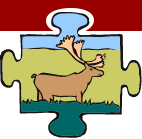VEGETATION
Indicators
- Vegetation cover/abundance*
- Phenology and growth changes
- Forest fire regimes*
- Presence of contaminants*
- Disease and insect outbreaks
- Habitat quality
- Herbivory
- Distribution/migration
- Frequency (rare plants)*
- Natural variation
* Trend graphs are available for indicators highlighed in orange.
|
Trend Graphs (NEW)
|
Indicators
|
Trend Graphs
|
| All Indicators |
- NWT Species Monitoring Infobase
(Web site)
|
| Vegetation Cover/Abundance |
- Plant Watch (Web site)
- Fore more information, see National Forest Information System (Web site)
|
| Forest Fire Regimes |
- Fore more information, see Government of the Northwest Territories Environment and Natural, Resources Forest Management Division, Fire Management (Web site)
|
| Presence of Contaminants |
|
Frequency
(Rare Plants) |
|
Current Knowledge
Most of the vegetation in the NWT belongs to the boreal forest or tundra. Black Spruce dominates the boreal forest, whereas a variety of shrubs and plants are present above treeline. There are over 1200 species of trees and plants in the NWT, not counting lichens and mosses. Changes in vegetation type happen over small to very large areas and over short to very long periods of time. Forest fires are the most important cause of change in boreal forest affecting wildlife and people, and changing the species of vegetation present. Insect and disease outbreaks can affect large areas of forest as well. Forest fires, insect infestations and disease, are all natural occurrences within the boreal forest.
The relationship between vegetation and wildlife is a close one. Most wildlife depends on vegetation for food and shelter, therefore changes in vegetation also affect wildlife. Changes in vegetation due to flooding and droughts, climate change and land use often have noticeable effects on wildlife. On the other hand, wildlife which feed selectively on certain species, or that overgraze because of large populations, can in turn stress vegetation. This relationship however, is not fully understood.
It is unknown if changes in distribution or abundance of different types of vegetation are happening within the NWT. A program to map NWT vegetation using remotely sensed data is underway. This is the first step in being able to notice unusual changes in vegetation, such as may happen due to climate change. The level of contaminants in the NWTs vegetation is currently unknown.
Current Monitoring
- NWT Species 2006-2010 General Status of Wild Species in NWT Study GNWT
- GNWT species rank infobase Government of the Northwest Territories (GNWT)
- Plantwatch NWT Ecological Monitoring and Assessment Network (EMAN)
- International Tundra Experiment - Canadian Tundra and Taiga Experiment
- West Kitikmeot Slave Study - WKSS Society
- Habitat / vegetation classification for the West Kitikmeot Slave Study Region GNWT
- Habitat of Dogrib Traditional Territory: Place Names as Indicators of Bio-geographical Knowledge - Dogrib Treaty 11 Council
- Plant biodiversity monitoring - Nahanni National Park Preserve
- Vegetation mapping in the Gwich'in Settlement Area - GNWT and Gwich'in Renewable Resources Board
- Studies of Environmental Effects of Disturbances in the Subarctic (SEEDS) - University of Alberta
- Forest production data- GNWT
- Tree biomass and decomposition monitoring - Nahanni National Park Preserve
- Forest Monitoring Plots, Campbell Lake - Gwich'in RRB
- Forest Monitoring Plots, NWT Canadian Forest Service (CFS)
- Archives of forest fire records GNWT
- Fire history of the NWT GNWT
- Tibbitt Lake post fire study GNWT
- Aerial monitoring surveys for insect outbreaks and diseases GNWT
- Small-scale pheromone trap monitoring program for Spruce Budworm GNWT
- International Boreal Experiment (IBEX) - Nahanni National Park Preserve
- Climate change impacts on the productivity and health of aspen - CFS
Gaps and Recommendations
There need to be more ground-truthing studies done, to verify that vegetation types identified from the air are correct. More studies involving local knowledge of medicinal plant species need to be done, to identify rare species and traditional use patterns. There is little information about the past distribution of forest fires, and the re-establishment of vegetation. Long-term revegetation studies are necessary.
Information gaps might be best filled by providing more support to existing monitoring programs such as Plantwatch NWT, the International Tundra Experiment, and the International Boreal Experiment, as well as community-based programs to document traditional knowledge about forest and plant species. The current network of forest health and biodiversity monitoring plots maintained by the Canadian Forest Service and the Smithsonian Institute/Man and the Biosphere Biodiversity Program should be expanded. Monitoring of spruce budworm and other insects should be done yearly.
Source: A Preliminary State of Knowledge of Valued Components for the NWT Cumulative Impact Monitoring Program (NWT CIMP) and Audit - Final Draft. February 2002; updated February 2005 and June 2007.
For more details, you may also want to look at:
-
Vegetation Excerpt
-
VC State of Knowledge Full Report
-
Projects on Vegetation
- NWT Environmental Audit 2005 - Supplementary Report on the Status of the Environment
- Other Resources: Canadian Forest Service Traditional Ecological Knowledge database (NEW)
- United Nations Environment Program (UNEP) World Conservation Monitoring Center (WCMC) Species Database (NEW)
Top of page


